Remembering Prof. A. Macdonald, and Our Days of 1928-1932
Amulyadhan Deb, 1932 Mechanical Engineering.
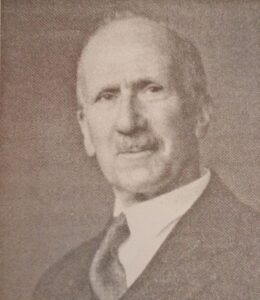
“If you travel by rail for 100/200 miles and whatever rail tracks, bridges, roads and engineering constructions you see, you should know that most of those were built with the supervisions of engineers of Shibpur and Roorkee.”
This is what Prof. Macdonald told me when I was selected for my apprenticeship with the Indian Railway.
*******
Our Prof. A. Macdonald was the first non-engineer Principal of our college in our early thirties. He taught us mathematics, with Prof. J.M. Bose (Bar-at-Law), who used to give us home task at the flat rate of 50 correct repetitions for each incorrect solution or answer. Prof. Macdonald’s predecessors in office were all Civil engineers and their sectarian outlook was not imperceptible. I recollect our Prof. Macdonald’s effort for the recognition of BE College by the Chartered Institution of UK. He carried the design plates of fourth year student Phani Chakrabarty, while he went on furlough.
It was Prof. Macdonald who introduced B.E. degree in Mechanical engineering for the students of 1932, and then for Electrical stream in the year 1934. Before that, the syllabi of Civil and Mechanical engineering diploma were the same for the first two years, that was known as Intermediate Engineering (I.E.) examination. 3 students from our batch passed I.E. in 1930, along with Civil engineering students. Immediately after, he announced the introduction of Mechanical engineering and offered us the option of joining the degree course. Many of us agreed, and he then taught us Rigid Dynamics, accommodating students of Civil stream also. Instead of physics, we had metrology. Chemistry remained same as for Associateship examination. So, the introduction of a new Degree was smooth, and without any extra cost burden. At the end of third year, we had University examination for non-professional subjects (B.E. – non-prof). In our fourth year, our degree classes were same as Associateship classes. So, no major hurdle to cross. It was my proud moment when I received a post card at home written by none other than my Principal Prof. Macdonald that I ranked first in order of merit in my third year final examination.
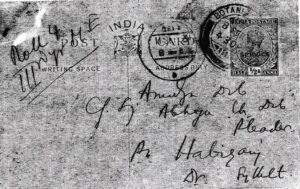
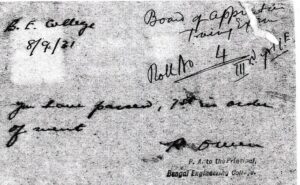
Sir Ashutosh Mukherjee Memorial Medal and Prize was introduced for the students who stands first in order of merit. I received it in 1931 for Mechanical and Electrical engineering stream, and Jamini Kumar Banerjee received for Civil engineering stream. There were many other medals and prizes also.
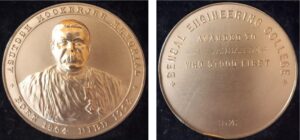
Tate Memorial Medal was introduced in memory Mr. W. Tate, our Professor of Chemistry, for the student who secures the highest marks in Science subject in the 3rd year annual examination, and I received the medal in my third year, i.e. in 1931 for Mechanical and Electrical engineering stream, and Ranajit Chanda received for Civil engineering stream. Ranajit received University Gold Medal also for securing top position in B.E. examination, 1932.
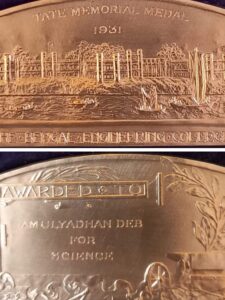
Days passed off smoothly, except for me, because my permission to take up degree course was not coming from DPI (Assam) before our non-prof examination. However, Prof. Macdonald allowed me to continue with my final year degree classes. As a result, I had to appear both in non-prof, as well as Associateship examinations, for a duration of 26 days. I recollect Prof. Macdonald’s anxiety about my health and strain, and took personal care for me for those 26 days. Finally, I could receive the permission, passed out in the first batch of Mechanical engineering degree in 1932, along with Sunil Das and Gunen Chatterjee. Prof. J. Riffkin was our teacher for Mechanical engineering. One point to mention that Benaras, Patna, Mysore and Poona had already introduced their degree courses for Mechanical stream much before ours.
The introduction of new degree course produced an impact in our campus life, and re-thinking about social relations began to crystalise. Earlier only Civil stream was offered the Degree course, and college had only one club for engineering students, operating from old hospital building, with its own library, and offering social service like evening classes for artisan boys. In 1930, it moved to the building adjacent to slater hall.
Central wing of Downing hostel had Mechanical students’ club. Every Thursday students used to sing Kirton. Haribhakti Pradayini Sabha used to publish the Kirton brochures. Mr. B.C. Mitra was our hostel superintendent. And Civil students were staying in the western wing of library.
Interestingly, with the increase of Muslim students, soon the entire eastern block of Downing hostel was allotted for all Muslim students, with Janab K.A. Kamran as their superintendent. They had their own dining hall at the ground floor, but their kitchen was at the nearby servant’s quarter.
Now with the introduction of degree course, a feeling developed amongst many students’ minds that Civil and Mechanical students were on equal footings. Few students were suffering from superiority complex, and it was not that all the students accepted the doctrine spontaneously. The protagonists of equality in rank were prominent enough in formation of different clubs. Downing hostel formed Downing House Club, irrespective of whether he is from Mechanical or Civil stream. Similarly different clubs were formed: Slater House Club, and Heaton House Club for the Anglo-Indian students. Finally, another society was formed for the students of Mechanical Engineering. Under this circumstances, Prof. Macdonald thought of forming a students’ institute, for representation in a common platform. He called us, saying a draft must be made for unity of all the students, irrespective of their courses. It was not unreasonable that our unity should be definitely expressed in our campus life, and even after our passing out. He was stressing on a true common reunion involving all the streams.
It was then Prof. A. Macdonald, advised all the students to form a common society & the BECSI ((B.E. College Student’s Institute) was announced on 11th April 1932 at our Assembly Hall (what we now know as Institute Hall). The membership for students was made compulsory. It had 4 units at Downing Hall, Slater Hall, Heaton Hall, & European Barrack. Rules were framed out, all simple rules. College would bear the subscription cost. BECSI was founded in the premise of old hospital (now demolished). Though rules were framed, but one particular clause “maintain the rights of students” was not approved by the government. It was as expected and not so unusual as the ruling British government was always alert if any group of youth or students are forming any association or club, whatever it be. The bomb explosion in 1906 by the revolutionary Ullaskar Dutta in the heart of our BE College campus was also an example. However, it was Prof. Macdonald who was determined that it was not related to any political intention. He stood like a rock. Finally, it was approved, in 1941, much after his tenure in BE College.
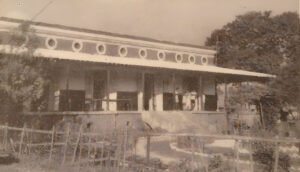
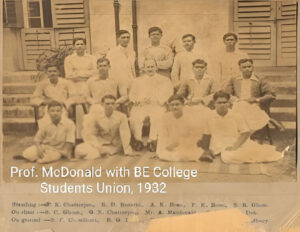
Photo shows the BECSI office and the first Executive Committee with students of Mechanical and Civil stream. Prof. Macdonald was the President, Sourin Dutta as Vice President, and myself as the Secretary. Our BECSI started in all earnest to end the rancour prevailing amongst different streams. Then the Engineering Students’ Club (for students of Civil and Mechanical stream) was formed, Rai Bahadur Chunilal Sarkar was invited in our inauguration program. We immediately celebrated our Bengali New Years’ Day (1932) which was attended by Prof. Macdonald and Prof. Miller. We had 3 sub committees: Library, Social, and Social Gathering. Arrangements were made with St. John ambulance for first-aid certificate examination.
With the blessings of Prof. Macdonald, and a new responsibility on me as the Secretary, our next plan was to unify the two different Reunion functions into a common one. During that time, Rai Bahadur Girish Chandra Das, was very popular among the old Civil engineering boys. He attended the 1932 reunion, and then when we approached him for an combined reunion, he said “No”, and narrated his strained relation with the diploma students of his time. He could not forget that a bucket full of night soil was spread over his bed ((at his time, the activated sludge plant was not installed), and he would never forgive those even at that age. It was contended that many were serving in Calcutta Corporation under the Chief Engineer Suresh Sanyal, a diploma holder in Overseer examination from our college. Rai Bahadur said it was so in office, but within the college precincts, they could not sit in the same bench with Diploma holders. Important to mention that Diploma holders were also invited in our reunions). The attitude reached such a fanaticism the even after the introduction of unified reunion, some old boys of Civil stream, boycotted the event, and they had their own steamer party reunion. When Prof. Wolfenden of Mechanical engineering department became the Principal, he also patronised the idea of unified reunion.
BECA Magazine:
Record says, a multilingual but mostly in Bengali journal Shibpur College Patrika started in 1903, and government granted Rs.100/- for that, but it was not regular. Long after that, in 1928 during our first year, the students of Civil engineering published a magazine Engineers’ Annual. In 1931, on the occasion of reunion, students of Mechanical stream published our first B.E. College Annual (BECA), combining both Civil Engineers’ Annual, and Engineers’ Annual. My friend Kabiruddin Ahmed was the first editor. However, again we landed in dispute. Civil students objected to the name and boycotted the 1931 reunion. However, the BECA remained, and whatever BECA we see today, had its historical beginning in 1931, let’s not go into dispute who made it: Civil, or Mechanical? BECSI and BECA continued in full swing. Then college crest was designed through a competition.
Honestly, as the Secretary of BECSI, and having good ranks in merit list, I had the opportunity of several face-to-face interactions with Prof. Macdonald. The man was soft and kind but also a towering personality and strict disciplinarian. His life influenced me to the extent I can not describe in words.
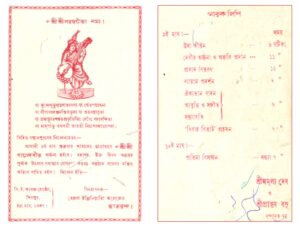
Clock Tower:
In earlier days, most of the students did not have any personal watch, but our authority was very strict that students must attend classes in time. They were dependent on our barrack employees who used to call us in early morning. Then Sir Rajendra Nath Mookherjee, our senior alumnus presented the too large Turret clock that was mounted at such a height that we could see the time from our hostel. To add, it had the bell also. This turret clock was installed much before our time, and we enjoyed its benefits.
Institute Hall:
The Institute Hall, as it it known now-a-days had two main purposes. The primary reasons were gathering of students for any occasion like lecture or student’s function or re-union. Additionally, it was often used by the Europeans for their social parties. The wooden floor was specially made to make it suitable as their dance floor.
Bakery:
Our commute with Calcutta was not so easy. Howrah bridge was in planning stage, so ferry was the only option. The European staff and students had a different food habit. So a bakery was founded at the backside of institute. A bell used to ring intimating people that the foods were ready. The bell was mounted at the top of its chimney with a small chandelier so as to save it from rain, and a light with it. Many people later thought it was a lighthouse. Our bakery was very popular with the Europeans, and we also often used to go for a different taste of foods.
CESC Tunnel:
CESC Tunnel was an interesting site for us. We used to form large group and reach Hooghly riverside at Botanical Garden. We could see labours, mostly from the state of Bihar used to dive deep and then come back after 2/3 minutes. The labours were digging a well on the Hooghly riverside of Botanical Garden. We were told that would be the first underwater tunnel in Asia, to be used for electric power transmission line from Kolkata to Howrah.
We, the B.E. College boys always enjoyed enviable status among the assembly of students during UTC (now a days known as NCC), and in Beighton Cup hockey tournament. College was declared unofficial holiday, and we marched in full uniform under the command of Major B.C. Gupta and Lt. Amaresh Chakrabarty, from the college ferryghat at Botanical Garden. Interestingly, our barrack employees carried Luchi and Egg Curry for us. We crossed the river Hooghly to Taktaghat, and again then marched for the Maidan. Our arrival was impressive and earned prestige from others. Our platoons were grouped with students of Presidency and Medical College. Our turnout was truly dignified inside the camp, as well as on parade ground.
I remember, in 1932 Beighton Cup we reached fourth round and lost to a Delhi team. Tennis was very popular with the European staff and their family. During our time, college made 10 new tennis courts by the side of Downing hostel. My batchmate Sudhir Kanjilal (Civil) created University record in long distance run.
Those were our hey-days of B.E. College.
Those who educate children well
are more to be honored than they who produce them;
for these only gave them life,
those the art of living well.
― Aristotle
** This article was first published in BECA edition, 1977.
** Source of article: Asim Deb, 1977 Electronics & Tele-communication Engineering.
** A few historical facts are added by Asim Deb, that he could know during several personal interactions with the author.
********
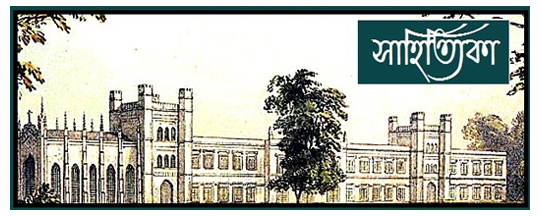

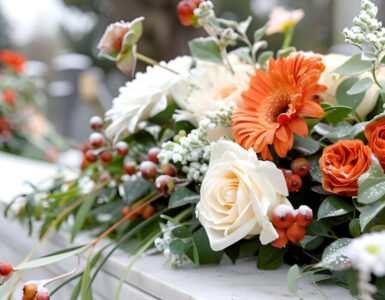
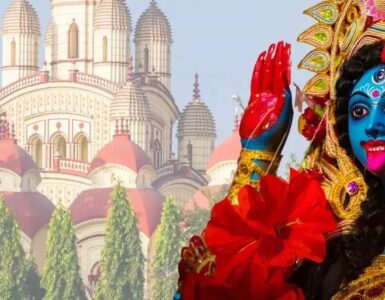
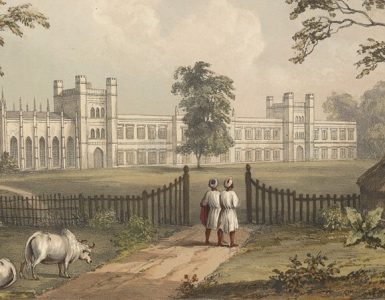









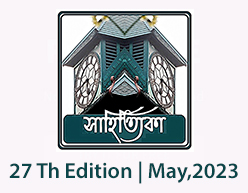

Absolutely wonderful recollection
দারুন তথ্য…..প্রায় গোটাটাই অজানা ছিলো। তার সঙ্গে আগে না-দেখা ছবির মেলবন্ধন, যেকোনো বিক্কলেজ সম্পর্কিত লোকের মন ছুঁয়ে যাবে।
লেখাটা পড়তে মনে হচ্ছিল আমি নিজেও সেই অতীত তে চলে গেছি। সেই 1932 অর্থাত 93 বছর আগের কলেজ। এত প্রাণবন্ত লেখা, প্রশংসার কোন ভাষা খুঁজে পাচ্ছি না। স্যার কে আমার প্রণাম। এটা একটা দলিল হিসাবে কোন তথ্য ভান্ডার এ রেখে দেওয়া উচিত। তাঁর সু যোগ্য পুত্র অসীম কে ধন্যবাদ, আবার আমাদের কাছে তুলে ধরার জন্য। 🙏
লেখাটা পড়তে মনে হচ্ছিল আমি নিজেও সেই অতীত তে চলে গেছি। সেই 1932 অর্থাত 93 বছর আগের কলেজ। এত প্রাণবন্ত লেখা, প্রশংসার কোন ভাষা খুঁজে পাচ্ছি না। স্যার কে আমার প্রণাম। এটা একটা দলিল হিসাবে কোন তথ্য ভান্ডার এ রেখে দেওয়া উচিত। তাঁর সু যোগ্য পুত্র অসীম কে ধন্যবাদ, আবার আমাদের কাছে তুলে ধরার জন্য। 🙏
This write-up is truly a treasure—a chronicle rich with valuable insights about my alma mater, Bengal Engineering College. It was written in the year 1970, by the late Sri Amulya Dhan Deb, an accomplished student of B E College 1928–1932 batch, and father of my college batchmate Ashim Deb.
What makes it even more remarkable is the clarity with which the article was composed, more than 38 years after his student days. It stands as a testament to the profound and lasting influence of those four years at BE College, and in particular, the enduring impact of Mr. A. McDonald on the author’s life.
সত্যি এই লেখাটা না পড়লে অনেক কিছুই জানতে পারতাম না। অসাধারণ একটা লেখা।আমার বন্ধু অসীম দেবের বাবার কলেজ লাইফের কিছু কথা। এই লেখা পড়ে তখনকার দিনে আমাদের কলেজ সমন্ধে বেশ কিছু তথ্য পেলাম যেগুলো আমাদের অনেকের কাছেই অজানা ছিলো। তখন হয়তো আমাদের কলেজ এখনকার মতো এতো বড় ছিলো না কিন্তু প্রত্যেকের মধ্যে একটা মিল বন্ধন এবং আন্তরিকতা ছিলো। প্রফেসর এবং ছাত্রদের মধ্যে একটা অমোঘ মিল বন্ধন ছিলো। যিনি এটা লিখেছেন তিনি অসামান্য মেধাবী ছিলেন। তিনি ওঁনার সময়কার অনেক তথ্য দিয়ে অনেক কিছু লিখেছেন যেগুলো জেনে আমাদের জ্ঞানের পরিধি বেড়ে গেলো। ওঁনার প্রতি আমার আন্তরিক শ্রদ্ধা রইলো।
আর অসীম দেব কে আমার অসংখ্য ধন্যবাদ জানাই এইরকম একটা লেখা আমাদের সামনে প্রকাশিত করার জন্য। 👌🏽🙏🏽❤
A very informative and interesting article indeed. It describes Prof. Macdonald’s personality, and contributions alongside many interesting facts unknown to me. The reason for putting a clock tower, CESC tunnel, The bakery, Re-union, apprenticeship, diploma and degree courses and the BECAA Magazine, to name a few.
Enjoyed thoroughly.